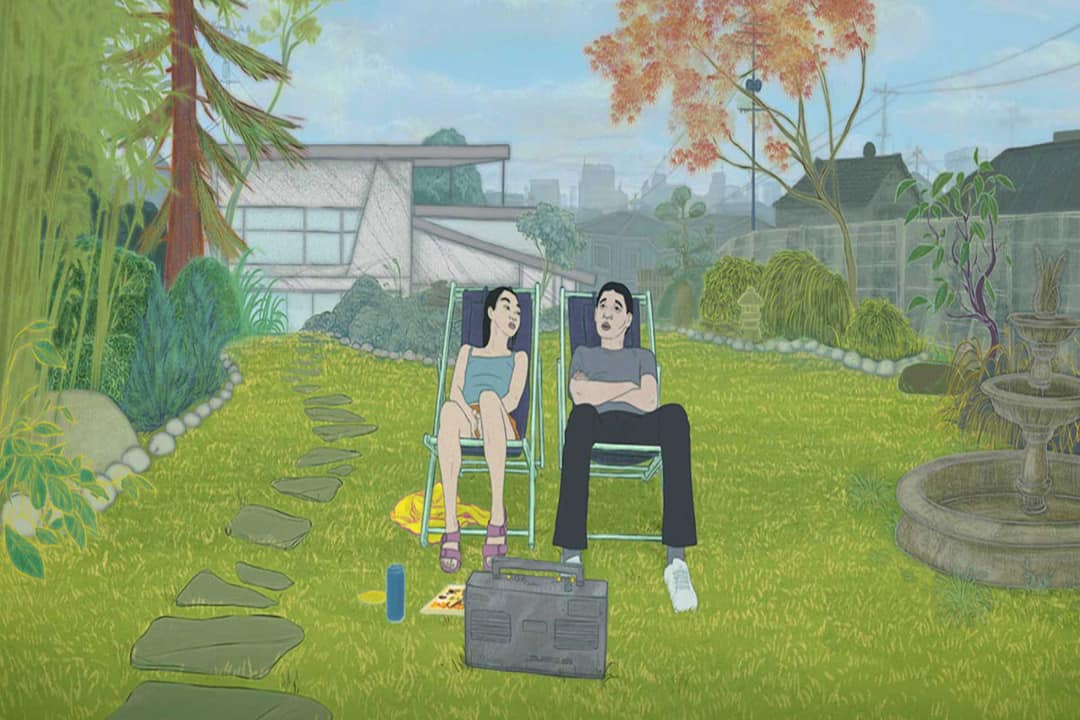When you enter your dreams, you may see strange characters with surreal expressions, clouds move with new purpose, and maybe, if you’re anything like director Pierre Földes, you might hear a playful violin. Földes’ first feature film, Blind Willow, Sleeping Woman creates this dreamy illusion seamlessly, making for a movie focused on reflection.
Földes was inspired by a number of stories by Japanese author Haruki Murakami, who is known for blurring the boundaries of reality. The stories follow three characters in the aftermath of the 2011 Tōhoku earthquake and tsunami: Komura, who struggles to know himself after his wife Kyoko leaves; Kyoko, herself, also wrestles with who she is, only having lived her life on her prescribed path; and anxious accountant Mr. Katagiri, who looks for purpose with the help of his own imagination — which includes a giant frog.
The characters themselves feel genuine, but it is Földes’ diligent attention to detail and his hunger for innovation in script-writing, animation, and score that makes Blind Willow, Sleeping Woman so human.
The script
Each character’s humanity is conveyed through their dialogue, which makes up the majority of the movie. In an interview with The Varsity, Földes specifically said that he did “not want to do what all the script writing textbooks [told him] to do,” where you create emotion using standard formulas, and we see the effect of his decision on the characters in big, predictable moments and acts, like screaming. He wanted to show that “film can evolve,” in the same way Murakami’s work has transformed writing through emphasizing the power of quiet, and sometimes unseen, feelings.
As a result, sadness, longing, relief, and all our favorite movie moment emotions come and go throughout the course of the film, yet they’re told more through subtle expressions in moments of reflection than anything else. Földes asked friends who understood Japanese, the original language of Murakami’s short stories, for assistance with translation to ensure that minimal detail was lost.
The animation
Similar to the script, Földes approached the art style of Blind Willow, Sleeping Woman with the goal of creating “something unique.” To capture the important expressions of each character, charts were made showing animators what any given expression on an actor’s face should look like on the animated character. For example, animators would show a raise of the eyebrow on Frog’s actor on Frog’s face, with the animated character’s eyebrow moving up significantly, making even the subtlest emotion standout more.
However, while our main characters become real, those around them seem only to exist to provide the main characters with what they need. For example, a boy with hearing loss has no greater purpose than to show Komura that it’s okay his wife has left. The works of Murakami that Földes takes on have rich side characters that Földes did not have the time or money to make as vital as our stars.
Still, it is difficult to watch people who could’ve become so real fade away with the trees and flowers, as though their only destiny was a cryptic word of wisdom to the leads. In a movie so focused on people’s emotions, their absence takes away the authenticity when we see that complex feelings are only granted to a handful of characters.
The score
However, in such universes, Földes’ atmosphere takes well deserved priority. For although the characters struggle to shake themselves out of their seemingly dead-end lives, they discover little friends and joys, such as a cat or a promotion. At its heart, the movie is one bursting with the humour of life, and the light score, composed by Földes himself, brings that out. After all, he “was not going to give all the fun [of composing] to someone else.”
Ultimately, it’s difficult to wake from Földes’ world, a world he built “from scratch,” a world in which, despite the malaise of ordinary life, one can reflect upon old habits and shake them away. As students, the bite of routine always lingers, and we wonder if the path we have chosen is the right one. However, we can always take new inspiration as we reflect.
Földes suggests that students hungry for change should start by “watching [his] film,” and creating something that matters to them — a step that will help them see the humour and hope among the gray drizzle of everyday life. Personally, when in need of inspiration, I read The Varsity!


